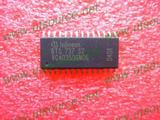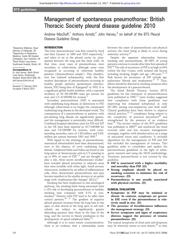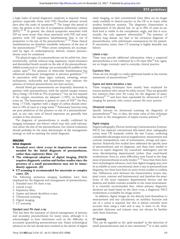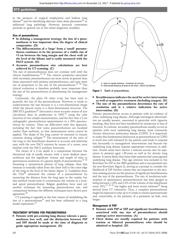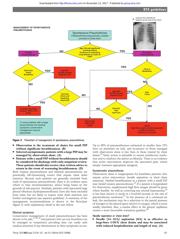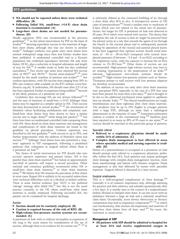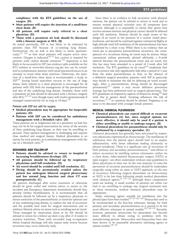
Management of spontaneous pneumothorax: British
Thoracic Society pleural disease guideline 2010
Andrew MacDuff,
1
Anthony Arnold,
2
John Harvey,
3
on behalf of the BTS Pleural
Disease Guideline Group
INTRODUCTION
The term ‘pneumothorax’ was first coined by Itard
and then Laennec in 1803 and 1819 respectively,
1
and refers to air in the pleural cavity (ie, inter-
spersed between the lung and the chest wall). At
that time, most cases of pneumothorax were
secondary to tuberculosis, although some were
recognised as occurring in other wise healthy
patients (‘pneumothorax simple’). This classifica-
tion has endured subsequently, with the first
modern description of pneumothorax occurring in
healthy people (primary spontaneous pneumo-
thorax, PSP) being that of Kjærgaard
2
in 1932. It is
a significant global health problem, with a reported
incidence of 18e28/100 000 cases per annum for
men and 1.2e6/100 000 for women.
3
Secondary pneumothorax (SSP) is associated
with underlying lung disease, in distinction to PSP,
although tuberculosis is no longer the commonest
underlying lung disease in the developed world. The
consequences of a pneumothorax in patients with
pre-existing lung disease are significantly greater,
and the management is potentially more difficult.
Combined hospital admission rates for PSP and SSP
in the UK have been reported as 16.7/100 000 for
men and 5.8/100 000 for women, with corre-
sponding mortality rates of 1.26/million and 0.62/
million per annum between 1991 and 1995.
4
With regard to the aetiology of pneumothorax,
anatomical abnormalities have been demonstrated,
even in the absence of overt underlying lung
disease. Subpleural blebs and bullae are found at the
lung apices at thoracoscopy and on CT scanning in
up to 90% of cases of PSP,
5 6
and are thought to
play a role. More recent autofluorescence studies
7
have revealed pleural porosities in adjacent areas
that were invisible with white light. Small airways
obstruction, mediated by an influx of inflammatory
cells, often characterises pneumothorax and may
become manifest in the smaller airways at an earlier
stage with ‘emphysema-like changes’ (ELCs).
8
Smoking has been implicated in this aetiological
pathway, the smoking habit being associated with
a 12% risk of developing pneumothorax in healthy
smoking men compared with 0.1% in non-
smokers.
9
Patients with PSP tend to be taller than
control patients.
10 11
The gradient of negative
pleural pressure increases from the lung base to the
apex, so that alveoli at the lung apex in tall indi-
viduals are subject to significantly greater
distending pressure than those at the base of the
lung, and the vectors in theory predispose to the
development of apical subpleural blebs.
12
Although it is to some extent counterintuitive,
there is no evidence that a relationship exists
between the onset of pneumothorax and physical
activity, the onset being as likely to occur during
sedentary activity.
13
Despite the apparent relationship between
smoking and pneumothorax, 80e86% of young
patients continue to smoke after their first episode of
PSP.
14
The risk of recurrence of PSP is as high as 54%
within the first 4 years, with isolated risk factors
including smoking, height and age >60 years.
12 15
Risk factors for recurrence of SSP include age,
pulmonary fibrosis and emphysema.
15 16
Thus,
efforts should be directed at smoking cessation after
the development of a pneumothorax.
The initial British Thoracic Society (BTS)
g
uidelines for the treatment of pneumothoraces
were published in 1993.
17
Later studies suggested
that compliance with these guidelines was
improving but remained suboptimal at only
20e40% among non-respiratory and A&E staff.
Clinical guidelines have been sh own to improve
clinical practice,
18 19
compliance being related to
the complexity of practical procedures
20
and
strengthened by the presence of an evidence
base.
21
The second version of the BTS guidelines
was published in 2003
22
andreinforcedthetrend
towards safer and less invasive management
strategies , together with detailed advice on a range
of associated issues and conditions. It included
algorithms for the management of PSP and SSP
but excluded the management of trauma. This
guideline seeks to consolidate and update the
pneumothorax guidelin es in the light of subse-
quent research and using the SIGN methodology.
Traumatic pneumothorax is not co vered by this
guideline.
<
SSP is associated with a higher morbidity
and mortality than PSP. (D)
<
Strong emphasis should be placed on
smoking cessation to minimise the risk of
recurrence. (D)
<
Pneumothorax is not usually associated
with physical exertion. (D)
CLINICAL EVALUATION
<
Symptoms in PSP may be minimal or
absent. In contrast, symptoms are greater
in SSP, even if the pneumothorax is rela-
tively small in size. (D)
<
The presence of breathlessness influences
the management strategy. (D)
<
Severe symptoms and signs of respiratory
distress suggest the presence of tension
pneumothorax. (D)
The typical symptoms of chest pain and dyspnoea
may
be relatively minor or even absent,
23
so that
1
Respiratory Medicine, Royal
Infirmary of Edinburgh, UK
2
Department of Respiratory
Medicine, Castle Hill Hospital,
Cottingham, East Yorkshire, UK
3
North Bristol Lung Centre,
Southmead Hospital, Bristol, UK
Correspondence to
Dr John Harvey, North Bristol
Lung Centre, Southmead
Hospital, Bristol BS10 5NB, UK;
john.harvey@nbt.nhs.uk
Received 12 February 2010
Accepted 4 March 2010
ii18 Thorax 2010;65(Suppl 2):ii18eii31. doi:10.1136/thx.2010.136986
BTS guidelines
group.bmj.com on November 12, 2017 - Published by http://thorax.bmj.com/Downloaded from

